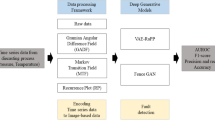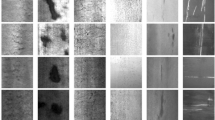Abstract
In modern industrial settings, the datasets available for mechanical fault diagnosis are often limited in size and exhibit significant imbalance posing a challenge to both the accuracy and stability of diagnostic processes. A particularly difficult task is the detection and localization of surface defects in textured materials. The complexity arises due to variable textures and the frequent scarcity of defective samples for preliminary testing. Conventional defect detection methods used in industry are typically complex, labor-intensive, and heavily dependent on expert knowledge due to the manual extraction of features and the complexity of the processing pipeline. To address these issues, the paper introduces an innovative imbalanced fault diagnosis approach leveraging the Fuzzy Clustering Generative Adversarial Network (FCGAN) model. The FCGAN is an advancement of the traditional Generative Adversarial Networks (GAN) which integrates fuzzy clustering into the discriminator’s training process for unsupervised learning. The integration of fuzzy clustering enhances the generative network’s performance. The model efficiency is further augmented by the feature extraction capabilities of FusionNet which undergoes structural optimization and conditional augmentation to generate diagnostic samples for machine faults. The effectiveness of the model is validated using two publicly accessible datasets i.e., DAGM 2007 synthetic and CCSD-NL Magnetic-Tile-Defect. The proposed method which is tested on two famous datasets, including DAGM 2007 synthetic and CCSD-NL Magnetic-Tile-Defect, has achieved prediction accuracy of 95.21% and 96.24% with a standard deviation of 65.78% and 57.44%, respectively. The results have been compared with other DL and traditional methods, including GAN, CNN, and adaptive deep CNN. The comparisons show that the proposed FCGAN data-driven fault diagnosis method has achieved significant improvements.















Similar content being viewed by others
Data availability
Inquiries about data availability should be addressed to the authors.
References
Abbas R, Gu N (2023) Improving deep learning-based image super-resolution with residual learning and perceptual loss using SRGAN model. Soft Comput 2023:1–17
Che C, Wang H, Lin R, Ni X (2022) Semi-supervised multitask deep convolutional generative adversarial network for unbalanced fault diagnosis of rolling bearing. J Braz Soc Mech Sci Eng 44(7):276
Dong W, Zeng H, Peng Y, Gao X, Peng A (2022) A deep learning approach with data augmentation for median filtering forensics. Multimedia Tools Appl 81(8):11087–11105
Formentini G, Boix Rodríguez N, Favi C (2022) Design for manufacturing and assembly methods in the product development process of mechanical products: a systematic literature review. Int J Adv Manuf Technol 120(7–8):4307–4334
Gebremeskel GB (2022) A critical analysis of the multi-focus image fusion using discrete wavelet transform and computer vision. Soft Comput 26(11):5209–5225
Guo W, Wang Y, Chen X, Jiang P (2023) Federated transfer learning for auxiliary classifier generative adversarial networks: framework and industrial application. J Intell Manuf 2023:1–16
Jan N, Gwak J, Pamucar D (2023) Mathematical analysis of generative adversarial networks based on complex picture fuzzy soft information. Appl Soft Comput 137:110088
Kim T, Behdinan K (2023) Advances in machine learning and deep learning applications towards wafer map defect recognition and classification: a review. J Intell Manuf 34(8):3215–3247
Li Y, Zou W, Jiang L (2022) Fault diagnosis of rotating machinery based on combination of Wasserstein generative adversarial networks and long short term memory fully convolutional network. Measurement 191:110826
Liu S, Jiang H, Wu Z, Liu Y, Zhu K (2022) Machine fault diagnosis with small sample based on variational information constrained generative adversarial network. Adv Eng Inform 54:101762
Lv Y, Zhou Q, Li Y, Li W (2021) A predictive maintenance system for multi-granularity faults based on AdaBelief-BP neural network and fuzzy decision making. Adv Eng Inform 49:101318
Mei Y, Fan Y, Zhang Y, Yu J, Zhou Y, Liu D, Fu Y, Huang TS, Shi H (2023) Pyramid attention network for image restoration. Int J Comput vis 131(12):3207–3225
Mengyao C, Yu T (2023) Intelligent product art design based on smart equipment and machine learning algorithm: practice effect and trend analysis. Soft Comput 2023:1–10
Nassehi A, Zhong RY, Li X, Epureanu BI (2022) Review of machine learning technologies and artificial intelligence in modern manufacturing systems. In: Design and operation of production networks for mass personalization in the era of cloud technology, pp 317–348. Elsevier, Amsterdam
Pan T, Chen J, Zhang T, Liu S, He S, Lv H (2022) Generative adversarial network in mechanical fault diagnosis under small sample: A systematic review on applications and future perspectives. ISA Trans 128:1–10
Qian G, Liu J (2022) Fault diagnosis based on conditional generative adversarial networks in nuclear power plants. Ann Nucl Energy 176:109267
Ribeiro LC, Rosa GHD, Rodrigues D, Papa JP (2022) Convolutional neural networks ensembles through single-iteration optimization. Soft Comput 26(8):3871–3882
Sun S, Hu X, Liu Y (2022) An imbalanced data learning method for tool breakage detection based on generative adversarial networks. J Intell Manuf 33(8):2441–2455
Wang Q, Yang R, Wu C, Liu Y (2021a) An effective defect detection method based on improved Generative Adversarial Networks (iGAN) for machined surfaces. J Manuf Process 65:373–381
Wang R, Zhang S, Chen Z, Li W (2021b) Enhanced generative adversarial network for extremely imbalanced fault diagnosis of rotating machine. Measurement 180:109467
Wang X, Jiang H, Liu Y, Liu S, Yang Q (2023) A dynamic spectrum loss generative adversarial network for intelligent fault diagnosis with imbalanced data. Eng Appl Artif Intell 126:106872
Xu C, Li W, Cui X, Wang Z, Zheng F, Zhang X, Chen B (2023) Scarcity-GAN: Scarce data augmentation for defect detection via generative adversarial nets. Neurocomputing 2023:127061
Yuan C, Marion T, Moghaddam M (2023) Dde-gan: integrating a data-driven design evaluator into generative adversarial networks for desirable and diverse concept generation. J Mech Des 145(4):041407
Zhang T, Liu S, Wei Y, Zhang H (2021) A novel feature adaptive extraction method based on deep learning for bearing fault diagnosis. Measurement 185:110030
Zheng X, Zheng S, Kong Y, Chen J (2021) Recent advances in surface defect inspection of industrial products using deep learning techniques. Int J Adv Manuf Technol 113:35–58
Funding
This study was funded by the 2024 Jilin Provincial Department of Education Scientific Research Project: Innovative Research on the Cultivation of Product Design Talent in Application-Oriented Universities under the Background of Artificial Intelligence (Contract No.: JJKH20241628SK).
Author information
Authors and Affiliations
Corresponding author
Ethics declarations
Conflict of interest
No conflict of interest has been declared by the authors.
Additional information
Publisher's Note
Springer Nature remains neutral with regard to jurisdictional claims in published maps and institutional affiliations.
Rights and permissions
Springer Nature or its licensor (e.g. a society or other partner) holds exclusive rights to this article under a publishing agreement with the author(s) or other rightsholder(s); author self-archiving of the accepted manuscript version of this article is solely governed by the terms of such publishing agreement and applicable law.
About this article
Cite this article
Wang, Y., Xue, Q. Fault identification of product design using fuzzy clustering generative adversarial network (FCGAN) model. Soft Comput 28, 3725–3742 (2024). https://doi.org/10.1007/s00500-024-09636-9
Accepted:
Published:
Issue Date:
DOI: https://doi.org/10.1007/s00500-024-09636-9




